Corrosion Behaviors of Weathering Steels in the Actual Marine Atmospheric Zone and Immersion Zone
Abstract
:1. Introduction
2. Materials and Methods
2.1. Materials and Sample Preparation
2.2. Atmospheric Zone and Immersion Zone Exposure Tests in the Actual Marine Environment
2.3. Corrosion Analysis and Characterization
3. Results and Discussion
3.1. Metallographic Structure
3.2. Corrosion Weight Loss and Local Corrosion Depth
3.3. Macroscopic Corrosion Morphology
3.4. Microscopic Corrosion Morphology
3.5. Composition of the Rust Layer
4. Conclusions
- A high Cl− concentration in the tropical marine atmospheric environment promotes the corrosion of the steel substrate due to the autocatalytic effect. γ-FeOOH and Fe3O4 occur within the corrosion product layer, ultimately promoting the cracking of the rust layer. Weathering steels facilitate the densification of the corrosion product layer due to the addition of alloying elements Cr, Ni, and Cu, thereby providing better corrosion resistance.
- In the marine immersion environment, metal dissolution intensifies at a high Cl− concentration due to its strong depolarization effect, resulting in local defects and corrosion pits. The corrosion products are loose and mixed. The corrosion process of steel 3# becomes fundamentally indistinguishable from that of other steels; hence, none exhibit good corrosion resistance.
- Steel 3# optimizes the alloying elements Ni, Cu, and Mo. The addition of Ni forms electronegative spinel oxides (NiFe2O4), further promoting rust nucleation and enhancing the compactness of the protective layer in the tropical marine atmospheric environment.
Author Contributions
Funding
Data Availability Statement
Conflicts of Interest
References
- Zhang, B.; Liu, W.; Sun, Y.; Yang, W.; Chen, L.; Xie, J.; Li, W. Corrosion behavior of the 3 wt.% Ni weathering steel with replacing 1 wt.% Cr in the simulated tropical marine atmospheric environment. J. Phys. Chem. Solids 2023, 175, 111221. [Google Scholar] [CrossRef]
- Sun, Y.; Liu, W.; Sun, Z.; Li, H.; Zhang, B.; Yang, W.; Chen, L.; Dong, B.; Zhang, T. Optimizing microstructure for enhanced atmospheric corrosion resistance of a novel Ni–Mo weathering steel: A field exposure study in Thailand’s tropical marine environment. Vacuum 2024, 221, 112876. [Google Scholar] [CrossRef]
- Melchers, R.E. A new interpretation of the corrosion loss processes for weathering steels in marine atmospheres. Corros. Sci. 2008, 50, 3446–3454. [Google Scholar] [CrossRef]
- Jia, J.H.; Wu, W.; Cheng, X.Q.; Zhao, J.B. Ni-advanced weathering steels in Maldives for two years: Corrosion results of tropical marine field test. Constr. Build. Mater. 2020, 245, 118463. [Google Scholar] [CrossRef]
- Yue, L.J.; Meng, Y.S.; Han, J.S.; Xie, K.; Sun, Y.P.; Tan, Y.L. Pitting corrosion behavior of Cu-P-RE weathering steels. J. Rare Earths 2023, 41, 321–330. [Google Scholar] [CrossRef]
- Melchers, R.E. Long-term corrosion of steels exposed to marine environments. Eur. J. Environ. Civ. Eng. 2009, 13, 527–546. [Google Scholar] [CrossRef]
- Zhou, M.; Liao, J.C.; An, L. Effect of Multiple Environmental Factors on the Adhesion and Diffusion Behaviors of Chlorides in a Bridge with Coastal Exposure: Long-Term Experimental Study. J. Bridge Eng. 2020, 25, 04020081. [Google Scholar] [CrossRef]
- Artigas, A.; Monsalve, A.; Sipos, K.; Bustos, O.; Mena, J.; Seco, R.; Garza-Montes-de-Oca, N. Development of accelerated wet–dry cycle corrosion test in marine environment for weathering steels. Corros. Eng. Sci. Technol. 2015, 50, 628–632. [Google Scholar] [CrossRef]
- Morcillo, M.; Alcántara, J.; Díaz, I.; Chico, B.; Simancas, J.; De la Fuente, D. Marine atmospheric corrosion of carbon steels. Rev. Metal. 2015, 51, e045. [Google Scholar] [CrossRef]
- Díaz, I.; Cano, H.; Lopesino, P.; de la Fuente, D.; Chico, B.; Jiménez, J.A.; Medina, S.F.; Morcillo, M. Five-year atmospheric corrosion of Cu, Cr and Ni weathering steels in a wide range of environments. Corros. Sci. 2018, 141, 146–157. [Google Scholar] [CrossRef]
- Wu, W.; Cheng, X.; Zhao, J.; Li, X. Benefit of the corrosion product film formed on a new weathering steel containing 3% nickel under marine atmosphere in Maldives. Corros. Sci. 2020, 165, 108416. [Google Scholar] [CrossRef]
- Zhang, T.Y.; Liu, W.; Chen, L.J.; Dong, B.J.; Yang, W.J.; Fan, Y.M.; Zhao, Y.G. On how the corrosion behavior and the functions of Cu, Ni and Mo of the weathering steel in environments with different NaCl concentrations. Corros. Sci. 2021, 192, 109851. [Google Scholar] [CrossRef]
- Hu, Q.; Yang, S.; Zhang, W.; Da, G.; Xu, X.; Wang, X. Corrosion failure analysis of engineering structural steels in tropical marine atmospheres: A comparative study of ordinary and new weathering steels. Eng. Fail. Anal. 2024, 156, 107830. [Google Scholar] [CrossRef]
- Morcillo, M.; Chico, B.; de la Fuente, D.; Aicantara, J.; Wallinder, I.O.; Leygraf, C. On the Mechanism of Rust Exfoliation in Marine Environments. J. Electrochem. Soc. 2017, 164, C8–C16. [Google Scholar] [CrossRef]
- Tamura, H. The role of rusts in corrosion and corrosion protection of iron and steel. Corros. Sci. 2008, 50, 1872–1883. [Google Scholar] [CrossRef]
- Morcillo, M.; Díaz, I.; Chico, B.; Cano, H.; de la Fuente, D. Weathering steels: From empirical development to scientific design. A review. Corros. Sci. 2014, 83, 6–31. [Google Scholar] [CrossRef]
- Morcillo, M.; Díaz, I.; Cano, H.; Chico, B.; de la Fuente, D. Atmospheric corrosion of weathering steels. Overview for engineers. Part II: Testing, inspection, maintenance. Constr. Build. Mater. 2019, 222, 750–765. [Google Scholar] [CrossRef]
- Feng, J.; Mikihito, H.; Kazuki, O.; Jia, L. An analysis on spatial properties of corroded surface of weathering steel by different environmental conditions. Corros. Eng. Sci. Technol. 2023, 58, 577–587. [Google Scholar] [CrossRef]
- Zhang, B.; Wang, Y.; Wan, H.X.; Deng, J.H.; Li, W.H.; Liu, F.Q. Actual Xisha marine atmospheric corrosion behavior of 30CrMnSiA steel in different parts of the aircraft. Eng. Fail. Anal. 2023, 154, 107684. [Google Scholar] [CrossRef]
- Miura, S.; Murase, M.; Okamoto, T.; Tung, D.D.; Iwasaki, E. Corrosion Behavior and Applicability of Weathering Steel in Vietnam. J. Mater. Civ. Eng. 2017, 29, 04016264. [Google Scholar]
- Vuong, V.D.; Nguyen, D.B.; Pham, N.T.; Tran, A.T.; Kawai, M.; Vu, A.Q.; Thao, N.D.; Le, T.V. Five-Year Field Exposure for Visualized Corrosion of STK400 Graded Steel Pile in Brackish Environment of Phu My Industrial Port (Southern Vietnam). J. Mater. Eng. Perform. 2022, 31, 2801–2809. [Google Scholar] [CrossRef]
- Jaén, J.A.; Guzmán, K.; Iglesias, J.; Manrique, G.C. Ten years outdoor exposure of steel in an urban and coastal tropical atmosphere. Corros. Eng. Sci. Technol. 2021, 56, 522–529. [Google Scholar] [CrossRef]
- Cano, H.; Neff, D.; Morcillo, M.; Dillmann, P.; Diaz, I.; de la Fuente, D. Characterization of corrosion products formed on Ni 2.4 wt%–Cu 0.5 wt%–Cr 0.5 wt% weathering steel exposed in marine atmospheres. Corros. Sci. 2014, 87, 438–451. [Google Scholar] [CrossRef]
- Wu, W.; Dai, Z.; Liu, Z.; Liu, C.; Li, X. Synergy of Cu and Sb to enhance the resistance of 3%Ni weathering steel to marine atmospheric corrosion. Corros. Sci. 2021, 183, 109353. [Google Scholar] [CrossRef]
- Nam, N.D.; Kim, M.J.; Jang, Y.W.; Kim, J.G. Effect of tin on the corrosion behavior of low-alloy steel in an acid chloride solution. Corros. Sci. 2010, 52, 14–20. [Google Scholar] [CrossRef]
- Sun, M.H.; Du, C.W.; Liu, Z.Y.; Liu, C.; Li, X.G.; Wu, Y.M. Fundamental understanding on the effect of Cr on corrosion resistance of weathering steel in simulated tropical marine atmosphere. Corros. Sci. 2021, 186, 109427. [Google Scholar] [CrossRef]
- Assumpção, R.F.; Silva, A.P.; Lins, V.F.C.; Sicupira, D.C. Corrosion Performance of New-Type Si-Based Weathering Steel in Marine Environment. J. Mater. Eng. Perform. 2022, 32, 8541–8548. [Google Scholar] [CrossRef]
- Misawa, T.; Hashimoto, K.; Shimodaira, S. The mechanism of formation of iron oxide and oxyhydroxides in aqueous solutions at room temperature. Corros. Sci. 1974, 14, 131–149. [Google Scholar] [CrossRef]
- Lair, V.; Antony, H.; Legrand, L.; Chaussé, A. Electrochemical reduction of ferric corrosion products and evaluation of galvanic coupling with iron. Corros. Sci. 2006, 48, 2050–2063. [Google Scholar] [CrossRef]
- Tanaka, H.; Mishima, R.; Hatanaka, N.; Ishikawa, T.; Nakayama, T. Formation of magnetite rust particles by reacting iron powder with artificial α-, β- and γ-FeOOH in aqueous media. Corros. Sci. 2014, 78, 384–387. [Google Scholar] [CrossRef]
- Martin, U.; Bastidas, D.M. Stress corrosion cracking failure analysis of AISI 1018 carbon steel reinforcing bars in carbonated and chloride contaminated environment. Eng. Fail. Anal. 2023, 147, 107159. [Google Scholar] [CrossRef]
- Alcántara, J.; Fuente, D.d.l.; Chico, B.; Simancas, J.; Díaz, I.; Morcillo, M. Marine Atmospheric Corrosion of Carbon Steel: A Review. Materials 2017, 10, 406. [Google Scholar] [CrossRef] [PubMed]
- Wu, W.; Cheng, X.; Hou, H.; Liu, B.; Li, X. Insight into the product film formed on Ni-advanced weathering steel in a tropical marine atmosphere. Appl. Surf. Sci. 2018, 436, 80–89. [Google Scholar] [CrossRef]


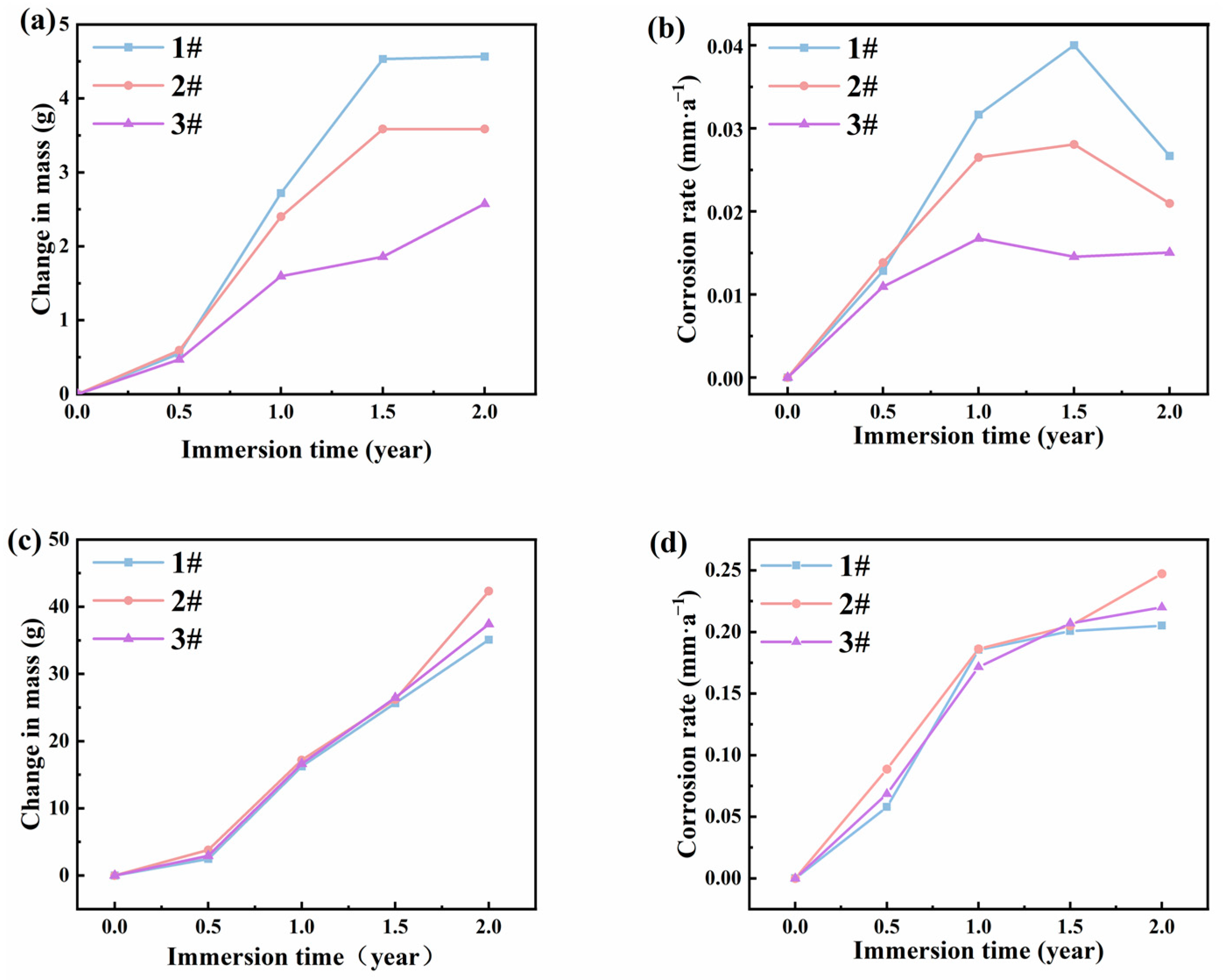

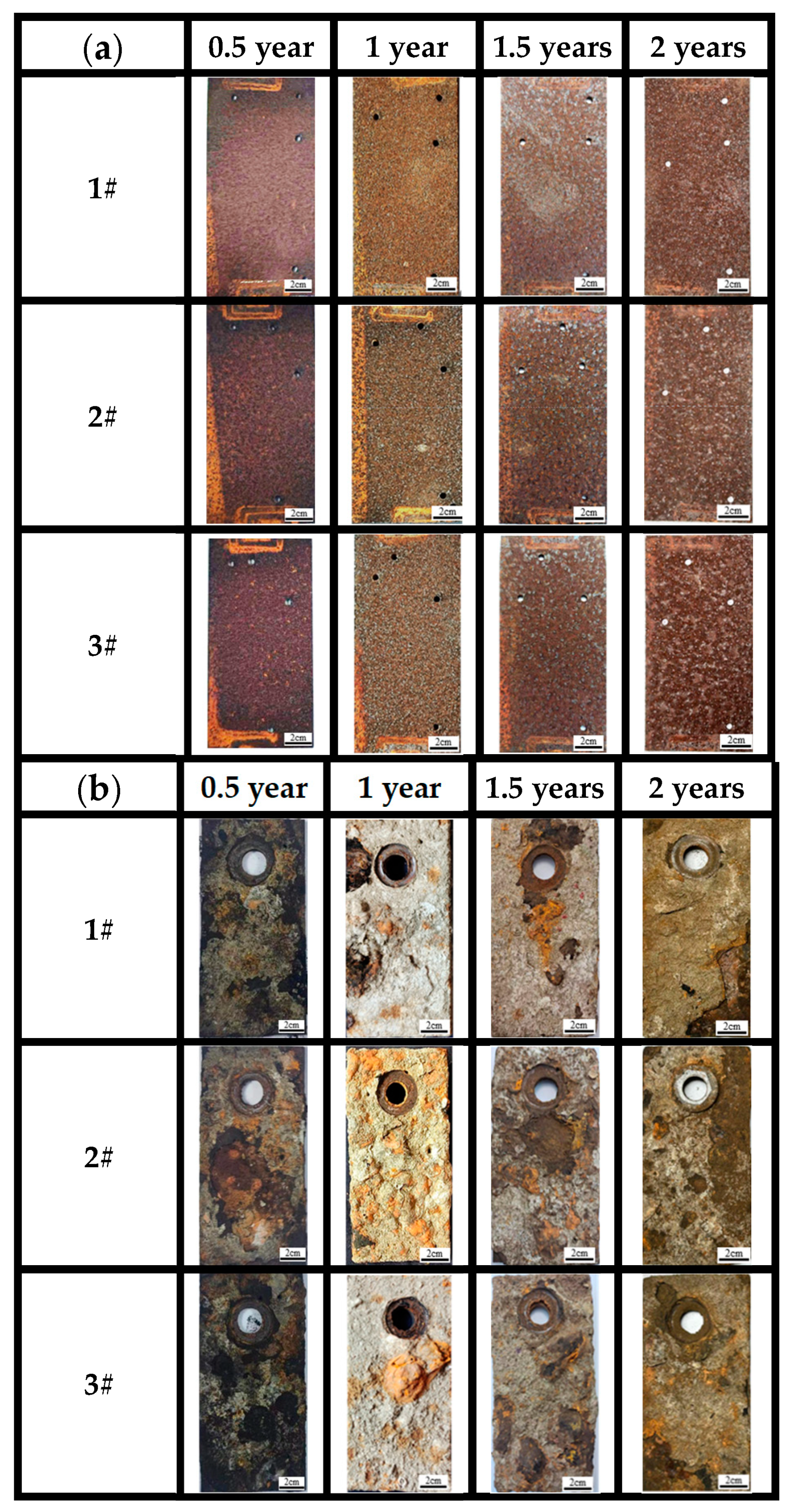

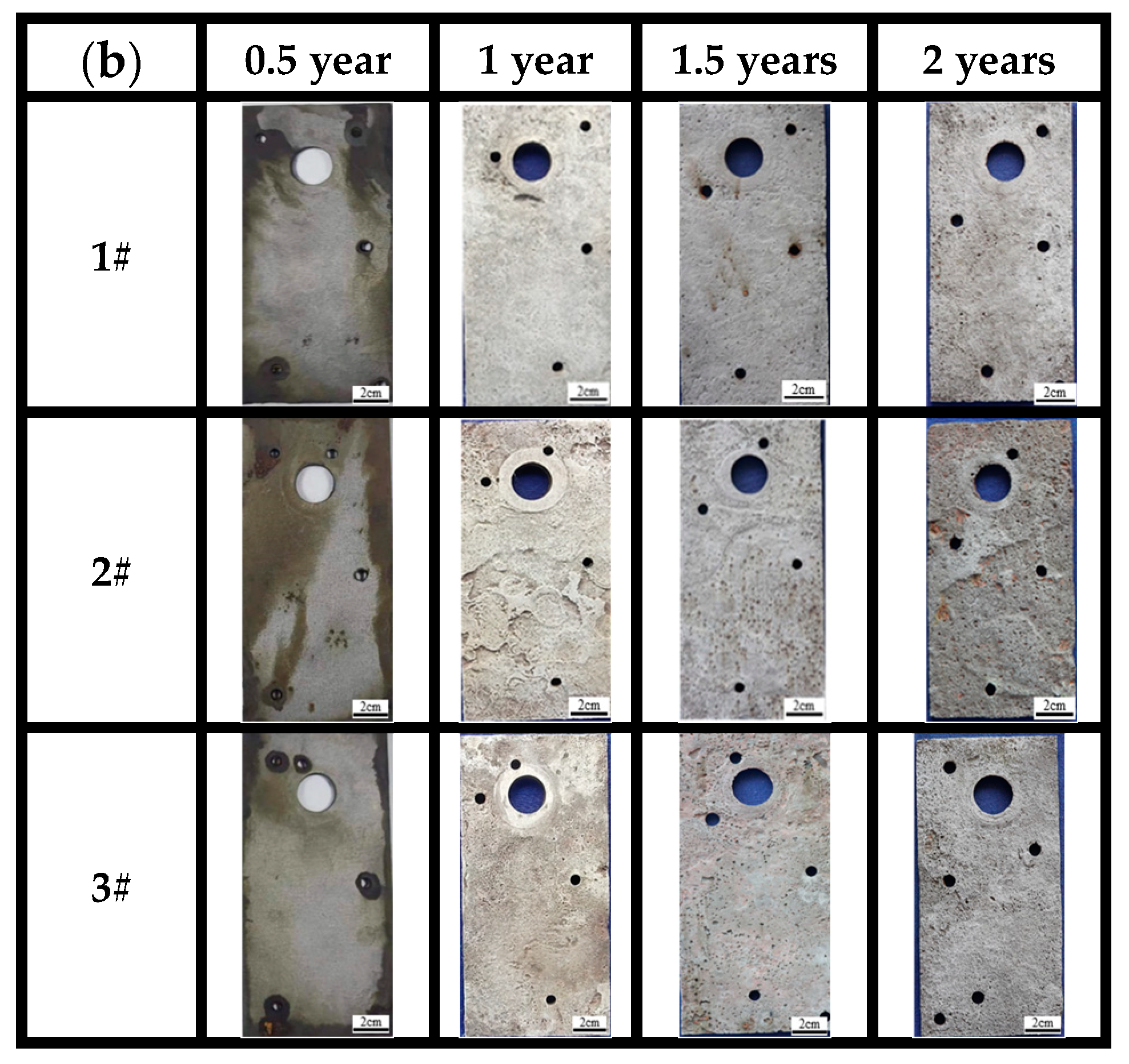
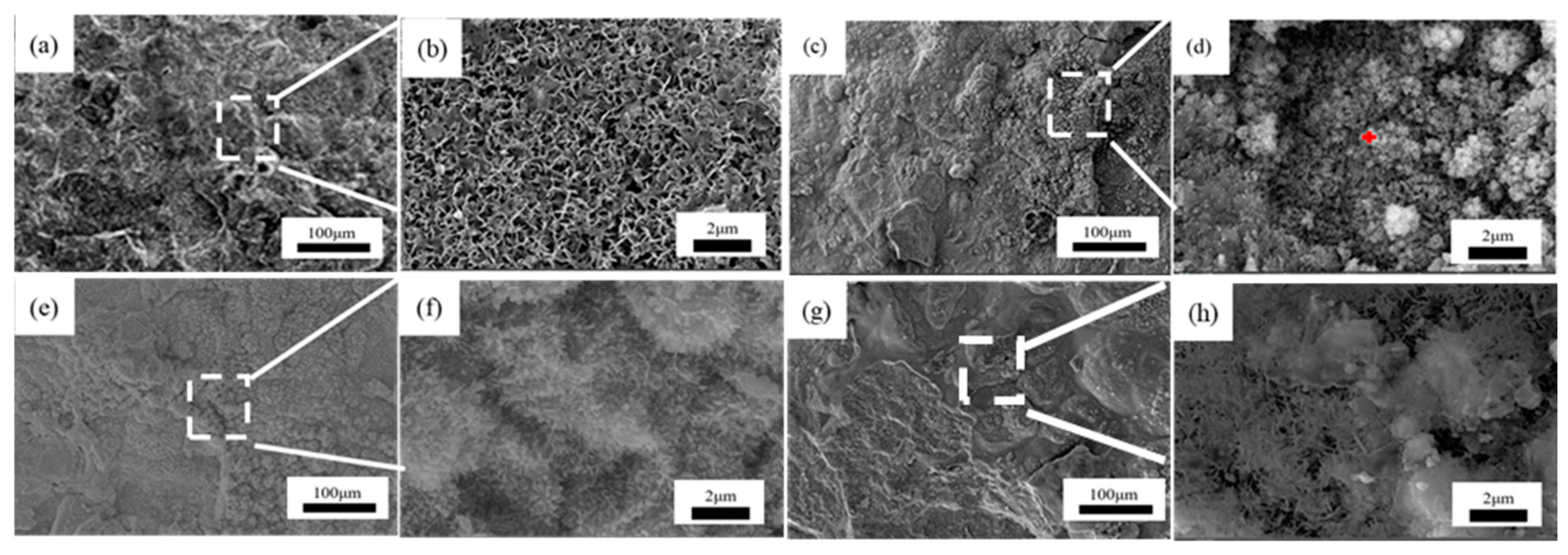

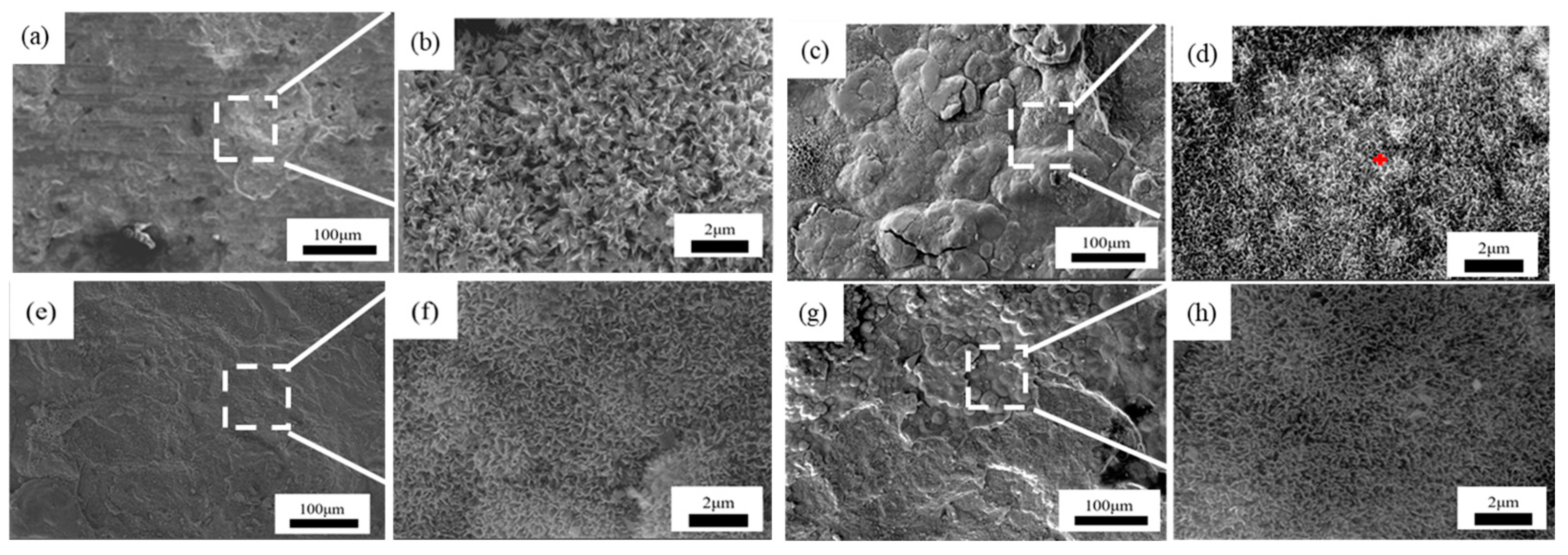


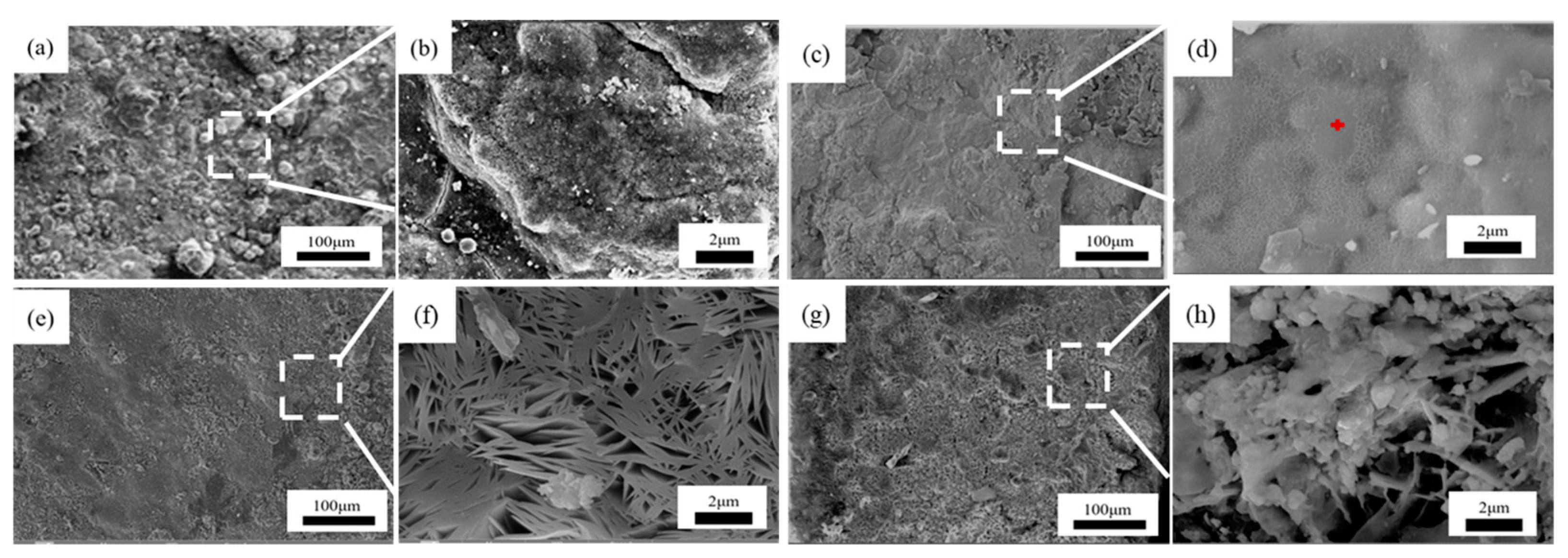

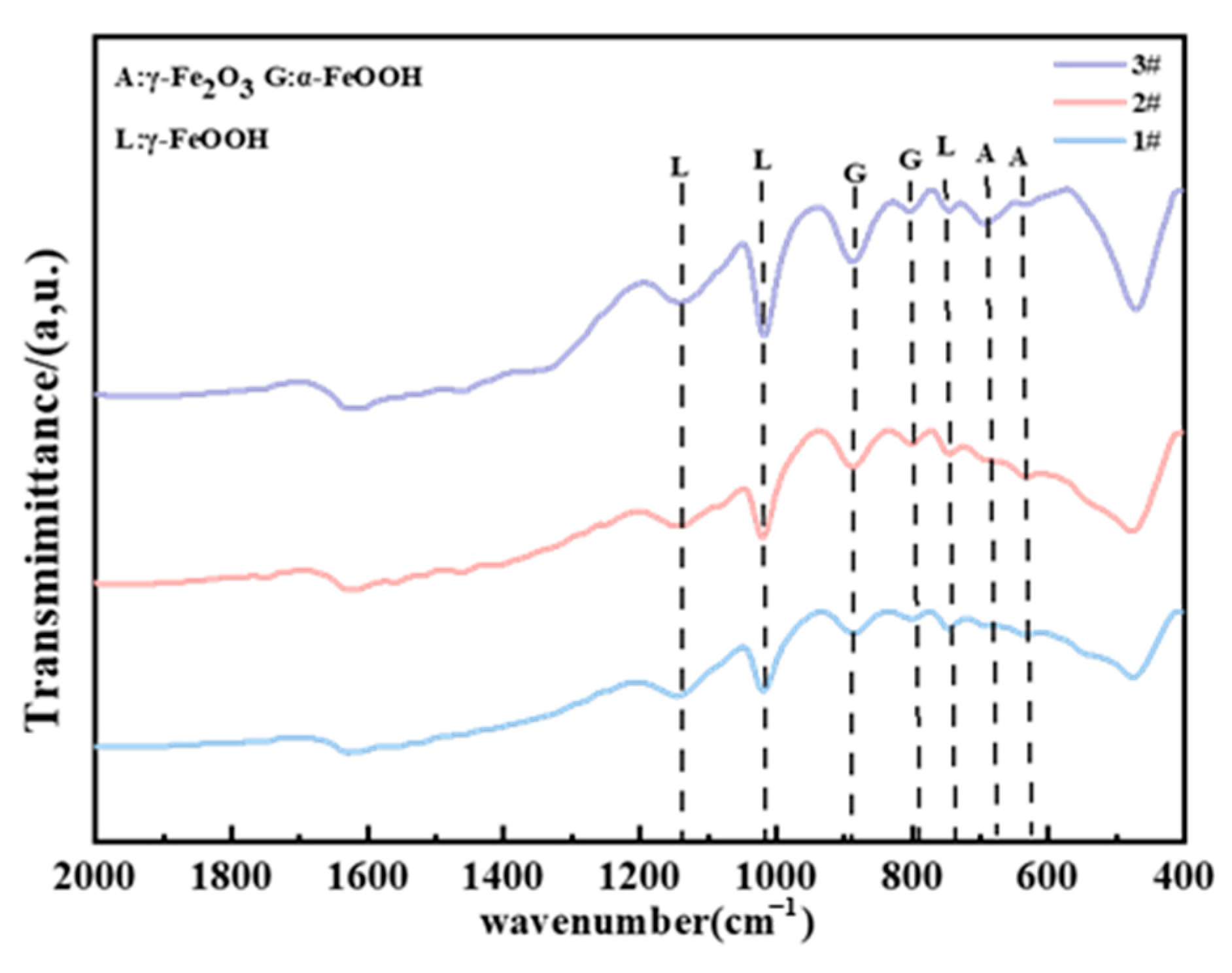
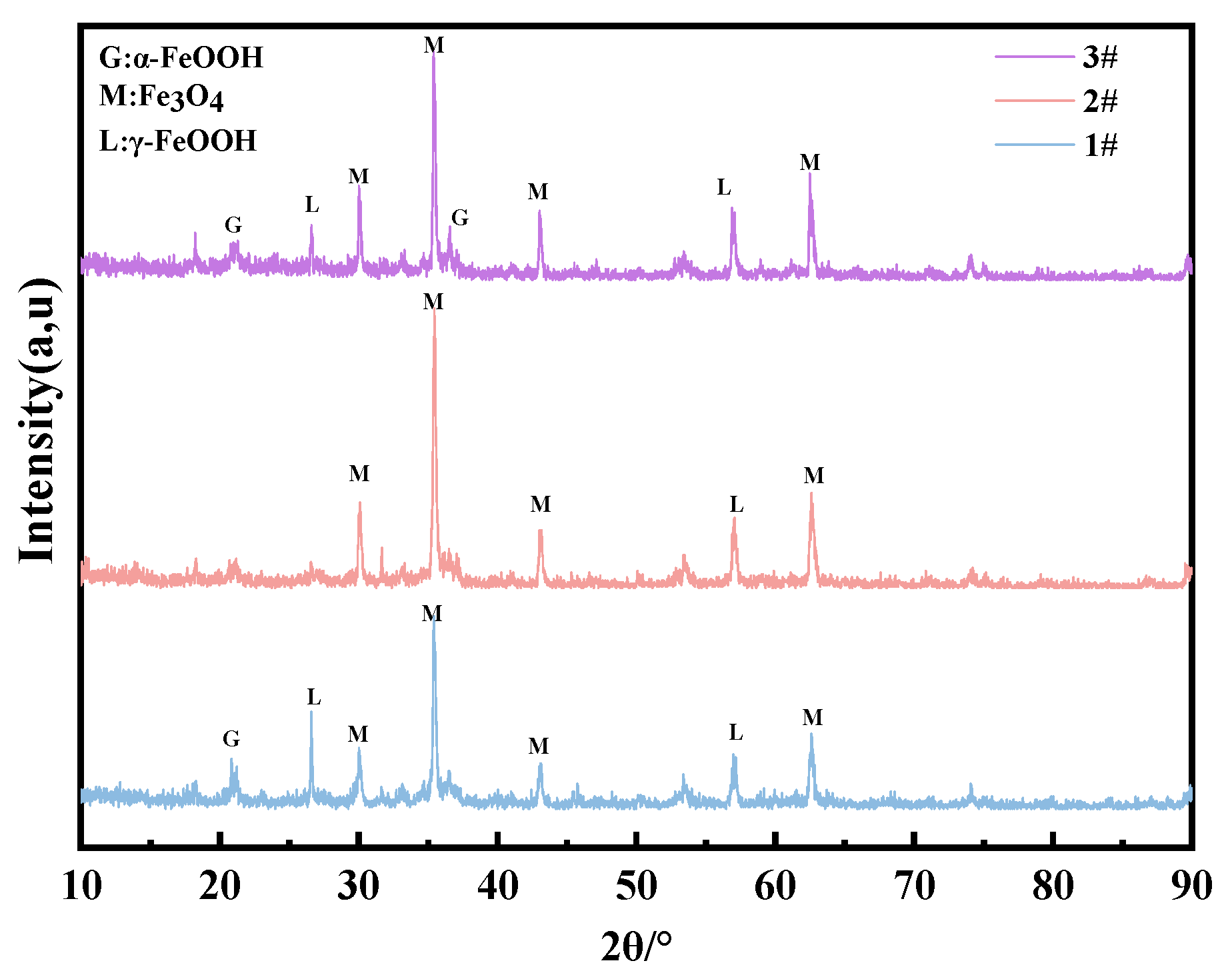
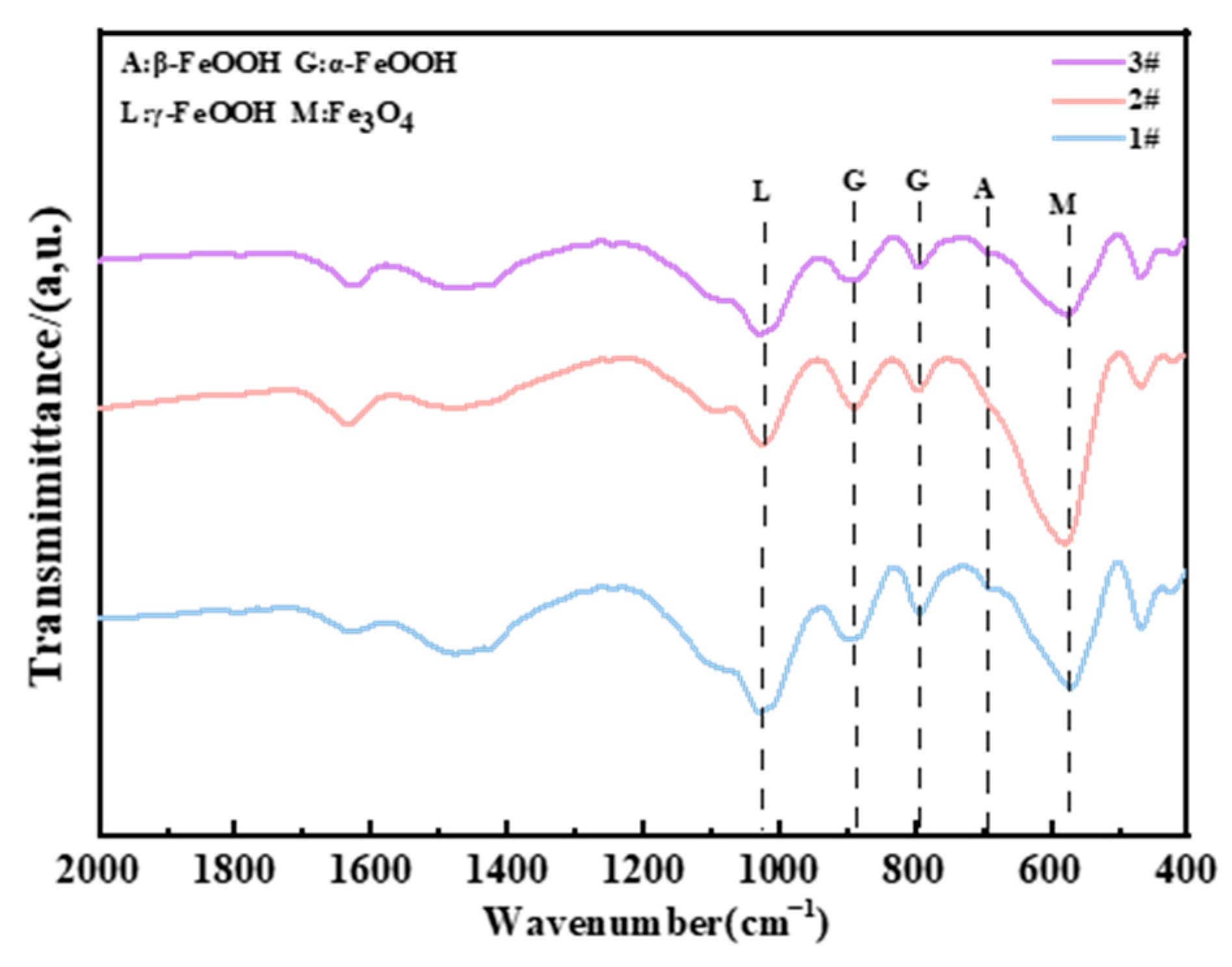
| Steel | C | Si | Mn | Cr | Ni | Cu | Mo | Nb |
|---|---|---|---|---|---|---|---|---|
| 1# | 0.12 | 0.30 | 1.35 | / | / | / | / | 0.010 |
| 2# | 0.065 | 0.35 | 1.15 | 0.60 | 0.30 | 0.45 | / | 0.015 |
| 3# | 0.06 | 0.40 | 1.10 | / | 3.30 | 0.78 | 0.25 | 0.010 |
Disclaimer/Publisher’s Note: The statements, opinions and data contained in all publications are solely those of the individual author(s) and contributor(s) and not of MDPI and/or the editor(s). MDPI and/or the editor(s) disclaim responsibility for any injury to people or property resulting from any ideas, methods, instructions or products referred to in the content. |
© 2024 by the authors. Licensee MDPI, Basel, Switzerland. This article is an open access article distributed under the terms and conditions of the Creative Commons Attribution (CC BY) license (https://creativecommons.org/licenses/by/4.0/).
Share and Cite
Yang, Y.; Lin, T.; Wang, G.; Wang, Y.; Shao, M.; Meng, F.; Wang, F. Corrosion Behaviors of Weathering Steels in the Actual Marine Atmospheric Zone and Immersion Zone. Metals 2024, 14, 903. https://doi.org/10.3390/met14080903
Yang Y, Lin T, Wang G, Wang Y, Shao M, Meng F, Wang F. Corrosion Behaviors of Weathering Steels in the Actual Marine Atmospheric Zone and Immersion Zone. Metals. 2024; 14(8):903. https://doi.org/10.3390/met14080903
Chicago/Turabian StyleYang, Ying, Tianzi Lin, Guohui Wang, Yubo Wang, Minghui Shao, Fandi Meng, and Fuhui Wang. 2024. "Corrosion Behaviors of Weathering Steels in the Actual Marine Atmospheric Zone and Immersion Zone" Metals 14, no. 8: 903. https://doi.org/10.3390/met14080903




